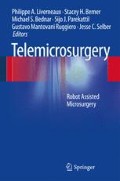Abstract
The nerve entrapment syndromes are an important issue in microsurgery.
Microsurgeons need to be able to recognize and choose the best approach to each case.
Advances in endoscopy have led surgeons to use this method to release nerves, achieving the best results by using a minimally invasive procedure.
Recently, the robotic surgery has also been introduced as a new surgical possibility presenting the following benefits: best gesture control, magnification and movement scaling.
The combination of both robotic surgery and endoscopy may be almost perfect for using in all nerve surgeries.
The evolution is dynamic and we are sure that many procedures will change in the future from open to robotic and finally to endorobotic surgery, and others directly from endoscopic to endorobotic.
We are experiencing an evolution of the surgical methods; thus we will share our current experience and future expectations in order to accomplish the state of the art in the release of the nerve entrapment syndromes.
All this evolution will require modifications in the robot. Indeed, by creating new robotic tools and new technologies, the possibilities will certainly expand.
The current framework for nerve decompression is presented in this chapter; however, as mentioned above, the possibilities can be expanded in the future.
Access this chapter
Tax calculation will be finalised at checkout
Purchases are for personal use only
References
Cahill BR, Palmer RE (1983) Quadrilateral space syndrome. J Hand Surg 8A:65–69
Disa JJ, Wang B, Dellon AL (2001) Correction of scapular winging by supraclavicular neurolysis of the long thoracic nerve. J Reconstr Microsurg 17:79–84
Francel TJ, Dellon AL, Campbell JN (1991) Quadrilateral space syndrome: diagnosis and operative decompression technique. Plast Reconstr Surg 87:911–916
Garcia JC, Mantovani G, Gouzou S et al (2011) Telerobotic anterior translocation of the ulnar nerve. J Robot Surg 5:153–156
Garcia JC (2009) Arthroscopic decompression of the suprascapular nerve: surgical technique. Tech Shoulder Elbow Surg 10:157–159
Guldmann R, Pourtales MC, Liverneaux P (2010) Is possible to use robots for carpal tunnel release? J Orthop Sci 15:430–433
Hempel GK, Shutz WP, Anderson JF et al (1996) Consecutive supraclavicular first rib resections for thoracic outlet syndrome. Ann Vasc Surg 10:456–462
Hoffmann R, Siemionow M (2006) The endoscopic management of cubital tunnel syndrome. J Hand Surg 31B:23–29
Jeon IH, Neumann L, Wallace WA (2005) Scapulothoracic fusion for painful winging of the scapula in nondystrophic patients. J Shoulder Elbow Surg 14:400–406
Kline DG (2008) Nerve action potential. In: Kline DG, Hudson AR (eds) Nerve injuries: operative results for major nerve injuries, entrapments and tumors, 2nd edn. WB Saunders, Philadelphia, p 83
Lafosse L, Piper K, Lanz U (2011) Arthroscopic suprascapular nerve release: indications and technique. J Shoulder Elbow Surg 20:S9–S13
Novak CB, Mackinnon SE (2002) Surgical treatment of a long thoracic nerve palsy. Ann Thorac Surg 73:1643–1645
Okutsu I, Ninomiya S, Takatori Y et al (1989) Endoscopic management of carpal tunnel syndrome. Arthroscopy 5:11–18
Post M, Grinblat E (1993) Suprascapular nerve entrapment: diagnosis and results of treatment. J Shoulder Elbow Surg 2:190–197
Povacz P, Resch H (2000) Dynamic stabilization of winging scapula by direct split pectoralis major transfer: a technical note. J Shoulder Elbow Surg 9:76–78
Author information
Authors and Affiliations
Corresponding author
Editor information
Editors and Affiliations
Rights and permissions
Copyright information
© 2013 Springer-Verlag France
About this chapter
Cite this chapter
Garcia, J.C. (2013). Nerve Entrapment. In: Liverneaux, P., Berner, S., Bednar, M., Parekattil, S., Mantovani Ruggiero, G., Selber, J. (eds) Telemicrosurgery. Springer, Paris. https://doi.org/10.1007/978-2-8178-0391-3_13
Download citation
DOI: https://doi.org/10.1007/978-2-8178-0391-3_13
Published:
Publisher Name: Springer, Paris
Print ISBN: 978-2-8178-0390-6
Online ISBN: 978-2-8178-0391-3
eBook Packages: MedicineMedicine (R0)

